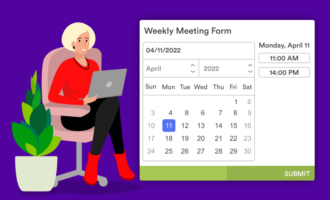As many managers are now finding out, remote teams have an entirely different dynamic than onsite teams — and that presents a whole new set of management challenges. How do you keep up team morale, ensure the important work is getting done, and keep everyone on the same page when you aren’t together in person?
You can’t just copy and paste your management style from the office to a remote setup. In fact, you may have to rethink your approach to management altogether. Here are five tips to help you lead a remote team.
Tips on leading a remote team
- Manage people’s results, not their time
- Strive for work-life alignment on your team
- Be intentional about team building and communication
- Use the right tools
- Trust your team to get work done
Manage people’s results, not their time
Strive for work-life alignment on your team
Be intentional about team building and communication
Use the right tools
Trust your team to get work done
“The number one difference is managing people’s results, not managing people’s time,” says Lance Cummins, president of Nectafy, a fully remote company. If you’re accustomed to evaluating performance based on the time workers put in — and monitoring how they use that time — you’ll have to rethink this approach with a remote workforce.
“It’s a huge change,” says Cummins. “We tend to treat people like resources on a factory line. The companies that can successfully transition are the ones that deputize their employees to get things done regardless of time.”
When it comes to regulating productivity, Cummins suggests individuals shift away from managing their time to managing their energy. Remote work is a different experience for workers psychologically. Encourage your team to take breaks, step away from their computers, and find the individual working habits and patterns that work best for them.
With remote work, there can be less of a divide between work and life, so it’s important the two complement each other.
“We talk about work-life balance, but I think what we should be striving for is work-life alignment,” says Cummins. He adds that remote managers should figure out what motivates their team members, then try to integrate their passions and strengths into the way the team works. This will improve employee retention, create a more enjoyable working environment, and produce more value in the long run.
“Maximize what makes remote work amazing, and make your team members happy, rather than push them to turn out more widgets,” Cummins advises.
Without the small talk, water cooler conversations, and all-hands meetings, it’s easy for remote workers to fall out of the loop if you don’t make the effort to stay in contact. “We’re social creatures at our very core…you have to give people the communication that’s necessary for everyone to know what’s going on,” says Brandon Riggs, senior consultant at Perceptyx.
Cummins suggests remote managers take a proactive approach to team building, including scheduling meetings just to catch up. “Intentionally create interactions that just happened in the office. That means doing a video for every interaction possible; it means doing group calls just to have fun. It sounds bizarre…but you have to create that culture.”
A successful remote team needs the right tools to keep everyone connected and on track to achieve the team’s priorities. Necessities include real-time collaboration and a messaging tool like Slack, project management software such as Asana or Trello, and a productivity suite like Google’s G Suite.
When choosing your tools, consider how they integrate with one another. Cummins says it’s critical that your digital tools speak to each other and that you’re keeping just one version of your data. This is why Jotform integrates with dozens of other services, so you can connect, simplify, and automate your workflows.
One of the main efficiencies of remote workers is that they can work without the distractions of an office environment. “The strength of remote work is that it gives employees the ability to get focused and work distraction free, away from other people. Let your people actually get deep work done,” recommends Cummins.
However, without a shared physical space, this also means remote managers won’t always be able to make instant requests of workers. Most communication will take place asynchronously. This requires a mental shift and a different set of expectations about communication.
Clearly set your team’s goals, establish times for your team to check in, and then let them do their jobs. “What that takes from a manager is so much beyond the technology,” says Cummins. “It takes trust.”
Riggs adds, “Trust is the most important thing we have as humans, and we show our trust and respect for each other by the way that we communicate. That’s the cornerstone of work and work-from-home policies. It’s all-around trust and communication.”











































































































Send Comment: